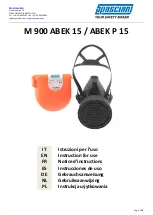
Chapter 3
NI 4350 Operation
©
National Instruments Corporation
3-7
Figure 3-2.
Effect of the Cold-Junction
With the NI 4350 instruments, you can perform cold-junction
compensation in software. To do this, you can use the thermistor
temperature sensor on the NI 4350 accessory to measure the ambient
temperature at the cold-junction and compute the appropriate
compensation for the unwanted thermoelectric voltages using software.
You have several options for performing cold-junction compensation,
as shown below.
•
If you are using the NI435X instrument driver, LabVIEW,
LabWindows/CVI, VirtualBench, or the DAQ Channel Wizard,
your software will automatically perform cold-junction
compensation on all channels configured as thermocouple
channels.
•
If you are using LabVIEW and are not using the instrument driver
or the DAQ Channel Wizard, your software includes examples that
perform these temperature-to-voltage and voltage-to-temperature
conversions for the cold-junction thermistor and various types of
thermocouples based on the National Institute of Standards and
Technology (NIST) standard reference tables. These examples are
located in the DAQ analog input example library and have 4350 in
their title.
•
If you are not using either of the previous software options, follow
the steps below to perform cold-junction compensation:
1.
Measure the resistance of the thermistor cold-junction sensor,
R
thermistor cold-junction
, and compute the cold-junction
temperature, T
cold-junction
, using the thermistor
resistance-temperature conversion formula.
2.
From this temperature of the cold-junction, T
cold-junction
,
compute the equivalent thermocouple voltage, V
cold-junction
, for
this junction using a standard thermocouple conversion
formula.
+
+
+
+
–
–
–
–
V
2
V
thermocouple
V
measured
V
1
V
measured =
V
thermo
V
1
– V
2
where V
1
– V
2
= V
cold-junction
















































